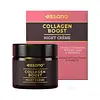What's inside
What's inside
 Key Ingredients
Key Ingredients

 Benefits
Benefits

 Concerns
Concerns

 Ingredients Side-by-side
Ingredients Side-by-side

Water
Skin ConditioningSesamum Indicum Seed Oil
EmollientPrunus Armeniaca Kernel Oil
MaskingGlyceryl Stearate
EmollientStearic Acid
CleansingGlycerin
HumectantTriethanolamine
BufferingTriticum Vulgare Germ Oil
EmollientCetyl Alcohol
EmollientLecithin
EmollientDimethicone
EmollientCymbopogon Martini Oil
MaskingCitrus Aurantium Dulcis Oil
MaskingAniba Rosaeodora Wood Oil
AstringentOenothera Biennis Oil
EmollientParfum
MaskingCarbomer
Emulsion StabilisingPhenoxyethanol
PreservativeXanthan Gum
EmulsifyingMethylparaben
PreservativePropylparaben
PreservativeTocopherol
AntioxidantTetrasodium EDTA
Water, Sesamum Indicum Seed Oil, Prunus Armeniaca Kernel Oil, Glyceryl Stearate, Stearic Acid, Glycerin, Triethanolamine, Triticum Vulgare Germ Oil, Cetyl Alcohol, Lecithin, Dimethicone, Cymbopogon Martini Oil, Citrus Aurantium Dulcis Oil, Aniba Rosaeodora Wood Oil, Oenothera Biennis Oil, Parfum, Carbomer, Phenoxyethanol, Xanthan Gum, Methylparaben, Propylparaben, Tocopherol, Tetrasodium EDTA
Water
Skin ConditioningHelianthus Annuus Seed Oil
EmollientLinum Usitatissimum Seed Oil
PerfumingGlyceryl Stearate Citrate
EmollientCetearyl Alcohol
EmollientGlyceryl Caprylate
EmollientLysolecithin
EmulsifyingSclerotium Gum
Emulsion StabilisingXanthan Gum
EmulsifyingPullulan
Glycerin
HumectantSimmondsia Chinensis Seed Oil
EmollientRosa Canina Fruit Oil
EmollientDehydroacetic Acid
PreservativeBenzyl Alcohol
PerfumingParfum
MaskingPisum Sativum Extract
Skin ConditioningCyclodextrin
AbsorbentPotassium Sorbate
PreservativeTocopherol
AntioxidantTetrasodium Glutamate Diacetate
Lactic Acid
BufferingCitral
PerfumingCitronellol
PerfumingGeraniol
PerfumingLimonene
PerfumingLinalool
PerfumingWater, Helianthus Annuus Seed Oil, Linum Usitatissimum Seed Oil, Glyceryl Stearate Citrate, Cetearyl Alcohol, Glyceryl Caprylate, Lysolecithin, Sclerotium Gum, Xanthan Gum, Pullulan, Glycerin, Simmondsia Chinensis Seed Oil, Rosa Canina Fruit Oil, Dehydroacetic Acid, Benzyl Alcohol, Parfum, Pisum Sativum Extract, Cyclodextrin, Potassium Sorbate, Tocopherol, Tetrasodium Glutamate Diacetate, Lactic Acid, Citral, Citronellol, Geraniol, Limonene, Linalool
Ingredients Explained
These ingredients are found in both products.
Ingredients higher up in an ingredient list are typically present in a larger amount.
Glycerin is already naturally found in your skin. It helps moisturize and protect your skin.
A study from 2016 found glycerin to be more effective as a humectant than AHAs and hyaluronic acid.
As a humectant, it helps the skin stay hydrated by pulling moisture to your skin. The low molecular weight of glycerin allows it to pull moisture into the deeper layers of your skin.
Hydrated skin improves your skin barrier; Your skin barrier helps protect against irritants and bacteria.
Glycerin has also been found to have antimicrobial and antiviral properties. Due to these properties, glycerin is often used in wound and burn treatments.
In cosmetics, glycerin is usually derived from plants such as soybean or palm. However, it can also be sourced from animals, such as tallow or animal fat.
This ingredient is organic, colorless, odorless, and non-toxic.
Glycerin is the name for this ingredient in American English. British English uses Glycerol/Glycerine.
Learn more about GlycerinParfum is a catch-all term for an ingredient or more that is used to give a scent to products.
Also called "fragrance", this ingredient can be a blend of hundreds of chemicals or plant oils. This means every product with "fragrance" or "parfum" in the ingredients list is a different mixture.
For instance, Habanolide is a proprietary trade name for a specific aroma chemical. When used as a fragrance ingredient in cosmetics, most aroma chemicals fall under the broad labeling category of “FRAGRANCE” or “PARFUM” according to EU and US regulations.
The term 'parfum' or 'fragrance' is not regulated in many countries. In many cases, it is up to the brand to define this term.
For instance, many brands choose to label themselves as "fragrance-free" because they are not using synthetic fragrances. However, their products may still contain ingredients such as essential oils that are considered a fragrance by INCI standards.
One example is Calendula flower extract. Calendula is an essential oil that still imparts a scent or 'fragrance'.
Depending on the blend, the ingredients in the mixture can cause allergies and sensitivities on the skin. Some ingredients that are known EU allergens include linalool and citronellol.
Parfum can also be used to mask or cover an unpleasant scent.
The bottom line is: not all fragrances/parfum/ingredients are created equally. If you are worried about fragrances, we recommend taking a closer look at an ingredient. And of course, we always recommend speaking with a professional.
Learn more about ParfumTocopherol (also known as Vitamin E) is a common antioxidant used to help protect the skin from free-radicals and strengthen the skin barrier. It's also fat soluble - this means our skin is great at absorbing it.
Vitamin E also helps keep your natural skin lipids healthy. Your lipid skin barrier naturally consists of lipids, ceramides, and fatty acids. Vitamin E offers extra protection for your skin’s lipid barrier, keeping your skin healthy and nourished.
Another benefit is a bit of UV protection. Vitamin E helps reduce the damage caused by UVB rays. (It should not replace your sunscreen). Combining it with Vitamin C can decrease sunburned cells and hyperpigmentation after UV exposure.
You might have noticed Vitamin E + C often paired together. This is because it is great at stabilizing Vitamin C. Using the two together helps increase the effectiveness of both ingredients.
There are often claims that Vitamin E can reduce/prevent scarring, but these claims haven't been confirmed by scientific research.
Learn more about TocopherolWater. It's the most common cosmetic ingredient of all. You'll usually see it at the top of ingredient lists, meaning that it makes up the largest part of the product.
So why is it so popular? Water most often acts as a solvent - this means that it helps dissolve other ingredients into the formulation.
You'll also recognize water as that liquid we all need to stay alive. If you see this, drink a glass of water. Stay hydrated!
Learn more about WaterXanthan gum is used as a stabilizer and thickener within cosmetic products. It helps give products a sticky, thick feeling - preventing them from being too runny.
On the technical side of things, xanthan gum is a polysaccharide - a combination consisting of multiple sugar molecules bonded together.
Xanthan gum is a pretty common and great ingredient. It is a natural, non-toxic, non-irritating ingredient that is also commonly used in food products.
Learn more about Xanthan Gum